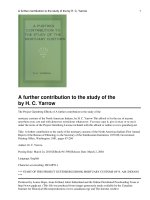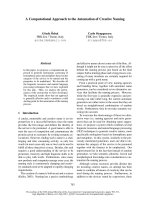Phlogacanthus geoffrayi Benoist (Acanthaceae): A new record to the flora of Vietnam
Bạn đang xem bản rút gọn của tài liệu. Xem và tải ngay bản đầy đủ của tài liệu tại đây (698.84 KB, 5 trang )
VNU Journal of Science: Natural Sciences and Technology, Vol. 36, No. 2 (2020) 49-53
Original Article
Phlogacanthus geoffrayi Benoist (Acanthaceae): A New
Record to the Flora of Vietnam
Do Van Hai1,2*, Duong Thi Hoan1, Ritesh Kumar Choudhary3
1
Institute of Ecology and Biological Resources, Vietnam Academy of Science and Technology,
18 Hoang Quoc Viet, Cau Giay, Hanoi, Vietnam
2
Graduate University of Science and Technology, Vietnam Academy of Science and Technology,
18 Hoang Quoc Viet, Cau Giay, Hanoi, Vietnam
3
Agharkar Research Institute, G.G. Agarkar Road, Pune-411 004, India
Received 14 October 2019
Revised 07 February 2020; Accepted 09 February 2020
Abstract: Phlogacanthus geoffrayi is reported here as a newly recorded species from Vietnam. This
species is morphologically allied to Phlogacanthus turgidus but differs in having a significantly
bigger calyx and staminodes. The specimens were collected from Song Cau district of Phu Yen
province. Description, line-drawing, photographs, and notes on ecology and distribution are
provided.
Keywords: New record, Acanthaceae, Phlogacanthus geoffrayi, Phu Yen, Vietnam.
1. Introduction
Cambodia but never from Vietnam [2,6,8-10].
Hence, it is reported here as a new addition for
the flora of Vietnam. A detailed description,
colour photos (Figure 1), and illustration (Figure
2) are provided here. With this addition, eleven
species are recognized in Phlogacanthus for the
flora of Vietnam.
The genus Phlogacanthus Nees belongs to
the tribe Andrographideae of the family
Acanthaceae [1,2]. It consists of about 40 species
distributed in the tropical regions of Asia [2]. In
Vietnam, the genus is represented by 11 species
[3]. During a floristic exploration trip to Song
Cau district of the Phu Yen province of Vietnam,
an interesting species of Phlogacanthus was
encountered. After thorough scrutiny of the
available literature and type materials it was
identified as Phlogacanthus geoffrayi Benoist
[4-7]. This species was so far recorded only from
________
2. Materials and Methods
2.1. Materials
Specimens of Phlogacanthus housed in the
herbaria E, HN, HNU, IBSC, K, P, VNM were
Corresponding author.
Email address:
/>
49
50
D.V. Hai et al. / VNU Journal of Science: Natural Sciences and Technology, Vol. 36, No. 2 (2020) 49-53
examined, and relevant literature were also
consulted [8-10]. Morphological comparison of
our specimen with allied species was carried out
for confirming the identity of the plant.
Vouchers were prepared following the standard
protocol [11]. Specimens of Phlogacanthus
geoffrayi were deposited in the herbarium of the
Institute of Ecology and Biological Resources,
VAST (HN).
2.2. Methods
The morphological comparison method was
used to study the plants. It is one of the most
suitable methods in plant taxonomic studies.
3. Results and Discussion
3.1. Key to the species of Phlogacanthus in
Vietnam
1A. Corolla tube cylindric and slightly curved.
2A. Bracteoles leaf-like, ovate to ovatelanceolate, > 12 mm long.
3A. Corolla red, 3-3.5 cm long
.......................................... 1. P. cornutus
3B. Corolla white with purple dotted stripes
on
throat,
1.5-1.8
cm
long
.................................................................
.................................................................
..................................... 2. P. annamensis
2B. Bracteoles not leaf-like, linear or subulate,
< 10 mm long.
4A. Corolla light yellow or white, 2-2.5 cm
long;
filaments
hirsute
at
base..
.................................................................
.................................................................
....................................... 3. P. publiflorus
4B. Corolla purplish red, 4.5-5 cm long;
filaments glabrous... .... . 4. P. curviflorus
1B. Corolla tube abruptly inflated near middle
and usually bent ca. 90°.
5A. Corolla outside pubescent with glandtipped trichomes.
6A. Corolla white or light purple; leaf blade
oblong to oblong-lanceolate; calyx 12-15
mm ...............................5. P. paniculatus
6B. Corolla pale yellow with thin to dense
purplish dots; leaf blade ovate to oblong;
calyx 7-10 mm .. .......................6. P. datii
5B. Corolla outside glabrous or non-glandular
pubescent.
7A. Bracteoles leaf-like, ovate to ovatelanceolate, > 10 mm long.
8A. Calyx > 10 mm, staminodes 4-5 mm
long. ............................... 7. P. geoffrayi
8B. Calyx < 7 mm, staminodes ca. 1 mm
long. ............................... 8. P. turgidus
7B. Bracteoles not leaf-like, linear, < 6 mm
long.
9A. Bracts leaf like, much longer than calyx;
corolla glabrous outside .........................
................................... 9. P. pyramidalis
9B. Bracts small and not leaf like, subequal
to calyx; corolla pubescent outside.
10A. Leaf blade secondary veins ca. 6 on
each side of midvein ..........................
............................. 10. P. abbreviatus
10B. Leaf blade secondary veins 9-17 on
each side of midvein ..........................
.................................. 11. P. colaniae
3.2. Taxonomic treatment
Phlogacanthus geoffrayi Benoist – Hỏa rô
geoffray (Figure 1 & 2).
Benoist, 1928. Bull. Soc. Bot. France, 74: 910;
Benoist, 1935. Fl. Gen. Indoch. 4: 706.
Shrubs 80 cm tall, erect. Stems quadrangular
or slightly 4-angled, glabrescent. Petiole 2-4
mm; leaf blade lanceolate, 5-10 × 18-28 cm,
glabrous on both side, base attenuate and
decurrent onto petiole, margin entire or sinuate,
apex acuminate to obtuse, secondary veins ca. 56 on each side of midvein. Inflorescences
terminal racemes, 10-15 cm tall; bracts
lanceolate, 12-15 × 4-5 mm, light purple, petiole
very short, puberulent on both side; bracteoles
very small, 1 mm long, or absent. Calyx ca. 10
mm, outside pubescent, lobes linear, ca. 8-9 × 1
mm, equal, apex acute. Corolla light purple, 2
cm long, ventricose, incurved, outside
pubescent; tube basally ca. 2 mm wide and short
then wide at middle; usually bent ca. 90º and
D.V. Hai et al. / VNU Journal of Science: Natural Sciences and Technology, Vol. 36, No. 2 (2020) 49-53
abruptly inflated near middle; limb 2-lipped;
lower lip 3-lobed, lobes ovate and equal, middle
lobes with the yellow patch; upper lip 2-lobed,
lobes ovate with acute at apex; lobes ascending
cochlear in bud. Stamens 2; filaments 10-12 mm,
glabrescent and basally pilose; anther thecae
oblong, 3-4 mm, connective barbate; staminodes
filiform, 4-5 mm. Ovary 3-4 mm, oblong,
glabrescent, with 4 ovules per locule; style ca. 15
mm, sparsely pubescent or glabrescent; stigma
2-cleft. Capsule clavate, 2.5-3 cm, pubescent, 8seeded. Seeds ovate, compressed.
51
Loc. class.: Cambodge: Kampot, chaîne de l'
Eléphant. Type: C. Geoffray 348 (holo.-P, photo!).
Flowering: March to May.
Ecology and habitat: Grows in the edge of
the forest, along roadside.
Distribution: Cambodia, Vietnam (Phu Yen
province, Song Cau district, Xuan Loc commune).
Specimens examined: VIETNAM, Phu Yen
province, Song Cau district, Xuan Loc
commune, N 13°39'41.3", E 109°10'52.0", D.V.
Hai s.n. (HN).
Figure 1. Phlogacanthus geoffrayi Benoist: a. Flowering and fruiting twig; b. Bracts; c. Calyx; d. Flower (front
view); e. Bract, calyx and flower; f. Flower (opened); g-h. Stamens; i. Ovary and style (Photos by D.V. Hai).
52
D.V. Hai et al. / VNU Journal of Science: Natural Sciences and Technology, Vol. 36, No. 2 (2020) 49-53
Figure 2. Phlogacanthus geoffrayi Benoist: a. Flowering twig; b. Bract; c. Calyx; d. Corolla (open) without
lower middle lobe; e. Lower middle lobe; f. Ovary and style (Illustration drawn by Mrs Le Kim Chi, from D.V.
Hai sine num., HN).
4. Conclusion
Understanding species diversity and
distribution record are important for biodiversity
assessment. An update to the available data
facilitates effective analysis and interpretation of
biodiversity and distribution data. Our research
for the first time reports occurrence of
Phlogacanthus geoffrayi in Vietnam, a species
hitherto known only from Cambodia. We believe
this report will help to understand the Vietnam
flora in a better way. At the same time, it will
help to prioritize the conservation strategy for
the country's valuable flora.
D.V. Hai et al. / VNU Journal of Science: Natural Sciences and Technology, Vol. 36, No. 2 (2020) 49-53
53
Table 1. Morphological comparison of Phlogacanthus geoffrayi with its allied species
Morphological
characters
Habit
Stems
Leaf
Inflorescence
Bract
Bracteole
Calyx
Corolla
Fruits
P. geoffrayi
P. turgidus [5,6]
shrubs, up to 80 cm tall
quadrangular or slightly 4-angled,
glabrescent
blade lanceolate, 5-10 × 18-28 cm,
glabrous
racemes, 10-15 cm long
lanceolate, 12-15 × 4-5 mm
1 mm long or absent
ca. 10 mm
light purple, ca. 2 cm long; lower lip 3lobed, lobes ovate and equal, middle lobes
with yellow patch
2.5-3 cm long
Acknowledgments
Authors are grateful to Mrs Le Kim Chi for
preparing the illustrations. Thanks are due to the
curators of HN, HNU, VNM and P herbaria for
the kind permission to access the herbarium
material. This research was funded by Vietnam
National Foundation for Science and
Technology Development (NAFOSTED) (grant
no 106.03-2017.301). RKC thanks Director,
Agharkar Research Institute, Pune for
encouragements.
References
[1] E.C.G. Nees, Acanthaceae Indiae Orientalis, in: N.
Wallich (Ed.), Plantae Asiaticae Rariores, Vol. 3,
Treuttel, Würtz, Richter, London, 1832, pp. 70-112.
[2] C. Xia, Y.F. Deng, Phlogacanthus yangtsekiangensis,
a new combination in Chinese Acanthaceae,
Phytotaxa 104 (1) (2013) 58-60. />11646/phytotaxa.104.1.9.
[3] D.V. Hai, N.T. Mai, N.T.T. Huong, R.K.
Choudhary, Y.F. Deng, An updated taxonomy of
the genus Phlogacanthus (Acanthaceae) in
Vietnam, Phytotaxa 372 (2) (2018) 167-175.
/>
shrubs 0.5-3 m tall
subterete and round on maturity, puberulent
blade lanceolate or oblong, 3-6 × 10-18 cm,
glabrous
thyrses, 5-20 cm long
lanceolate, 12-14 × 5-6 mm
oblong, ca. 10 × 3 mm, apex acute
4-7 mm
corolla white or pink, 2.5-3.5 cm long, lower
lip 3-lobed, middle lobes with purple dots.
3-4 cm long
[4] R. Benoist, Acanthacées nouvelles asiatiques,
Bulletin de la Société Botanique de France 74
(1928) 907-912. />1927.10837070.
[5] R. Benoist, Acanthacées, in: M.H. Lecomte (Ed.),
Flore Générale de l’Indochine, Vol. 4, Mason et
Cie, Paris, 1935, pp. 610-772.
[6] P.H. Ho, Acanthaceae, in: P.H. Ho (Ed.), An
Illustrated Flora of Vietnam, Vol. 3, Tre Publishing
House, Ho Chi Minh, 2000, pp. 30-82 (in
Vietnamese).
[7] T.K. Lien, Acanthaceae, in: N.T. Ban (Ed.),
Checklist of plant species of Vietnam, Vol. 3,
Agricultural Publishing House, Hanoi, 2005, pp.
251-281 (in Vietnamese).
[8] C.C. Hu, X.P. Fu, Phlogacanthus, in: L.K. Fu, T.
Hong (Eds.), Higher plants of China, Vol. 10.
Qingdao Publishing House, Qingdao, 2005, pp.
386-388.
[9] C.C. Hu, Phlogacanthus and Cystacanthus, In:
C.C. Hu (Ed.), Flora Reipublicae Popularis
Sinicae, Vol. 70, Science Press, Beijing, 2002, pp.
207-214.
[10] C.C. Hu, Y.F. Deng, T.F. Daniel, Phlogacanthus
and Cystacanthus, in: Z.Y. Wu, P. Raven, D.Y.
Hong (Eds.), Flora of China, Vol. 19, Science
Press, Beijing & Missouri Botanical Garden Press,
St. Louis, 2011, pp. 474-477.
[11] S.K. Jain, R.R. Rao, A Handbook of Field and
Herbarium Methods, Today and Tomorrow’s
Printers and Publishers, New Delhi, 1977.









